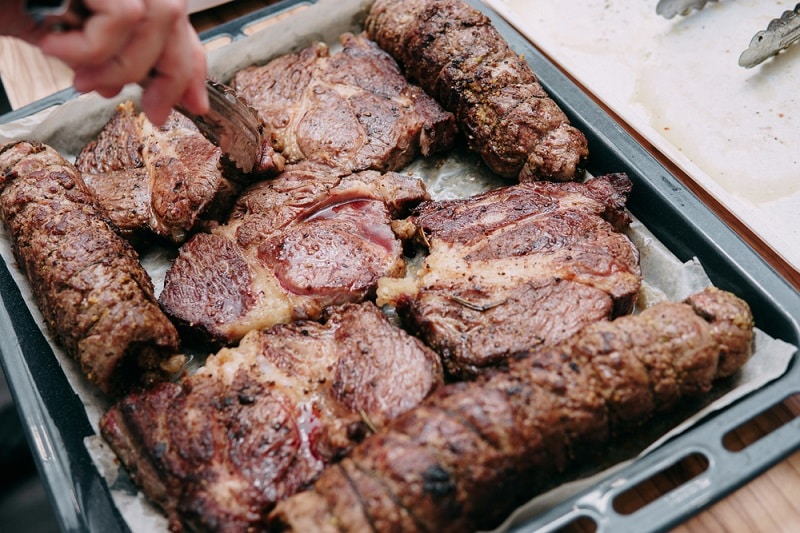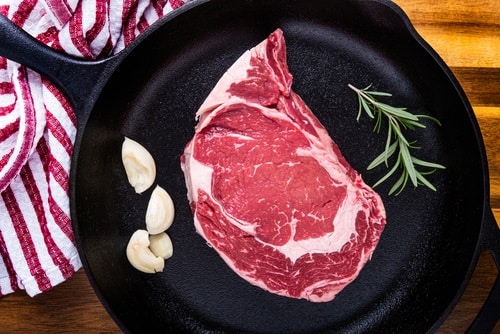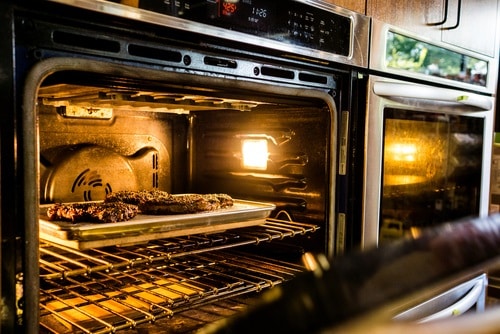
When the air starts turning colder, our minds start turning towards warming winter foods.
Juicy, tender steaks are winter’s hearty comfort foods, but many people don’t attempt to cook them because they’re put off by the long cooking times and complicated recipes. They also think that they have to have a cast-iron skillet for the job.
Yes, the best way to cook rib-eye steaks (if you aren’t going to barbeque them) is in a cast-iron skillet. This is the perfect utensil for getting a beautiful crisp crust on your steak, plus ensuring that it’s cooked through to your liking without drying out.
The method involves searing the steak on either side in the skillet over a scorching flame then finishing it off in the oven. What happens if you don’t have a cast-iron skillet, though? Are there any suitable substitutes? Read on because we have the answer for you!

How to Cook Ribeye Steak in the Oven Without a Cast-iron Skillet
This recipe will take around ten minutes for preparation and about half an hour for the total cooking and resting time. So, in this section, we have outlined the recipe that you can follow even if you don’t have a cast-iron skillet!
1. First of all, you need to collect the ingredients – the steak cuts, olive oil, sea salt, and ground black pepper.
2. Gather your tools – you’ll need a baking sheet, a pair of tongs, a heavy-based frying pan, and a sheet of foil to cover the steaks while they’re resting.

3. Next, preheat the oven to 390 degrees Fahrenheit and put the steaks onto the baking sheet.
4. Brush the steaks on both sides with some oil and season them with pepper and sea salt.
5. Roast the steaks on the middle rack of the oven for around twenty minutes to obtain a medium-rare finish. Obviously, this will depend on how thick the steaks are.
6. Before the cooking time is complete, heat some olive oil in the heaviest frying pan that you have over high heat on the stovetop. Finish the steaks off in this to give them a golden crust.
Things to Keep in Mind
- While cooking the ribeye steak in the oven without a cast-iron skillet, you can heat the frying pan for the last five minutes of cooking time.
- It is recommended that you use a pan with a copper core and heavy bottom because this will offer optimal heat retention.
- While using the pan, let the steaks get crispy and brown for three minutes on each side, and the edges must be cooked for one to two minutes. (Use a pair of kitchen tongs to hold the steaks on their sides to brown them.)
- You must not use a thin, nonstick pan because the temperature will be too high for this type of surface.
- Choose a pan with a size similar to the steak area because if the pan is too large, the empty sides will burn the juices and seasonings.

Browning the Ribeye Steak
The prime reason people brown their ribeye steaks is to optimize their aroma and flavor. When you put the steak into the pan from the oven tray, make sure that the pan is preheated. It must make a sizzling sound when the steak touches it. The pan must be hot enough!
Before cooking the steaks, please bring them to room temperature.
In addition, you need to ensure that the steak is not wet because wet steak in a tray of hot oil will spatter and make a mess. It would be best if you patted each steak piece dry with a clean dishtowel because a water layer will adversely impact the coloring and browning of the exterior.
So, once you have dried each steak, add the seasoning, then put the steaks onto the tray for an even cooking outcome.
A ribeye steak is not complete without a brown and crispy exterior. The addition of salt achieves this, so do not be tempted to cook it without any.
First of all, the salt will accentuate the flavor, and secondly, it will lead to caramelization. When the caramelization is done properly, the forming of a crispy crust will be easier.

Remember to brush the oil onto the steak and not onto the tray. If you oil the whole tray, the oil will start to smoke and will cause an unpleasant smell in your kitchen.
Do try our method of cooking ribeye steaks without a cast-iron skillet! It’s best done with relatively thin steaks, though thicker cuts will end up with dry edges and an undercooked center.
After cooking, remember to rest your steaks for about ten minutes, covered with foil, to allow the juices to sink back into the meat. Enjoy!